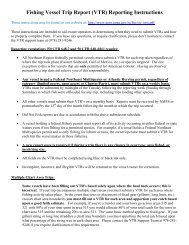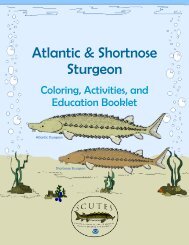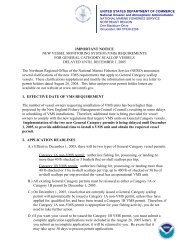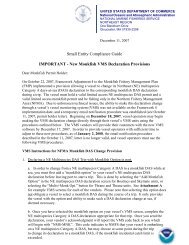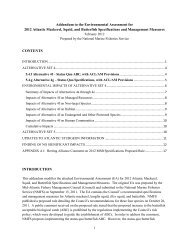modifications to the harbor porpoise take reduction plan - Northeast ...
modifications to the harbor porpoise take reduction plan - Northeast ...
modifications to the harbor porpoise take reduction plan - Northeast ...
You also want an ePaper? Increase the reach of your titles
YUMPU automatically turns print PDFs into web optimized ePapers that Google loves.
producing a consensus draft TRP that was submitted <strong>to</strong> NMFS on August 8, 1996. NMFS<br />
limited <strong>the</strong> geographic scope of <strong>the</strong> 1996 GOMTRT <strong>to</strong> focus only on bycatch off <strong>the</strong> coast of<br />
New England (Maine <strong>to</strong> Rhode Island). This was due <strong>to</strong> <strong>the</strong> high proportion of incidental<br />
bycatch in <strong>the</strong> Nor<strong>the</strong>ast multispecies sink gillnet fishery that constituted <strong>the</strong> majority of <strong>the</strong> <strong>to</strong>tal<br />
fishery-related mortality in <strong>the</strong> U.S. Additionally, <strong>the</strong>re was uncertainty about <strong>the</strong> extent of<br />
fisheries interactions in waters south of New England. Data on <strong>the</strong> bycatch of <strong>harbor</strong> <strong>porpoise</strong>s<br />
in <strong>the</strong> Mid-Atlantic were not available until 1996 due <strong>to</strong> low observer effort prior <strong>to</strong> 1995 and <strong>the</strong><br />
lag in availability of appropriate effort data <strong>to</strong> estimate bycatch. The GOMTRT convened with<br />
<strong>the</strong> understanding that a separate <strong>take</strong> <strong>reduction</strong> team (TRT) would be convened <strong>to</strong> address<br />
<strong>harbor</strong> <strong>porpoise</strong> bycatch in <strong>the</strong> Mid-Atlantic. The GOMTRT included representatives of <strong>the</strong><br />
Nor<strong>the</strong>ast sink gillnet fishery, NMFS, state marine resource management agencies, <strong>the</strong> NEFMC,<br />
<strong>the</strong> Atlantic States Marine Fisheries Commission (ASMFC), environmental organizations, and<br />
academic and scientific organizations.<br />
Soon after <strong>the</strong> GOMTRT submitted its draft TRP <strong>to</strong> NMFS, <strong>the</strong> NEFMC enacted Framework<br />
Adjustment 19 (61 FR 55774, Oc<strong>to</strong>ber 29, 1996) <strong>to</strong> <strong>the</strong> Nor<strong>the</strong>ast Multispecies FMP, which<br />
changed <strong>the</strong> time and area of <strong>the</strong> Nor<strong>the</strong>ast Multispecies FMP Mid-Coast Closure Area within<br />
<strong>the</strong> Gulf of Maine and established an exemption <strong>to</strong> allow sink gillnet vessels <strong>to</strong> fish inside <strong>the</strong><br />
reopened area when utilizing pingers on <strong>the</strong>ir nets. Based on this action, NMFS modified <strong>the</strong><br />
draft HPTRP <strong>to</strong> be consistent with Framework Adjustment 19 and published a proposed rule <strong>to</strong><br />
implement a HPTRP for <strong>harbor</strong> <strong>porpoise</strong>s in <strong>the</strong> Gulf of Maine (62 FR 43302, August 13, 1997).<br />
In February 1997, NMFS convened <strong>the</strong> Mid-Atlantic Harbor Porpoise Take Reduction Team<br />
(MATRT) <strong>to</strong> address <strong>the</strong> incidental bycatch of <strong>harbor</strong> <strong>porpoise</strong>s in Mid-Atlantic gillnet fisheries<br />
from New York through North Carolina. The MATRT included representatives of <strong>the</strong> Mid-<br />
Atlantic and Nor<strong>the</strong>ast gillnet fisheries, NMFS, state marine resource management agencies, <strong>the</strong><br />
Mid-Atlantic Fishery Management Council (MAFMC), <strong>the</strong> NEFMC, <strong>the</strong> ASMFC,<br />
environmental organizations, and academic and scientific organizations. Although <strong>the</strong> MATRT<br />
did not reach consensus on all issues discussed, <strong>the</strong> MATRT submitted a report <strong>to</strong> NMFS on<br />
August 25, 1997 which included both consensus and non-consensus recommendations.<br />
On September 11, 1998, NMFS published a proposed rule (63 FR 48670) for <strong>the</strong> HPTRP that<br />
included both <strong>the</strong> GOMTRT and MATRT proposals as one management <strong>plan</strong>. This replaced <strong>the</strong><br />
first proposed rule that published on August 13, 1997 (62 FR 43302). A final rule implementing<br />
<strong>the</strong> HPTRP was published on December 2, 1998 (63 FR 66464). Shortly following, a correction<br />
notice <strong>to</strong> <strong>the</strong> final rule was published (63 FR 71041, December 23, 1998). On January 11, 2001,<br />
NMFS published a final rule (66 FR 2336) amending <strong>the</strong> HPTRP by exempting Delaware Bay<br />
from HPTRP regulations landward of <strong>the</strong> 72 COLREGS demarcation line.<br />
The GOMTRT and MATRT were last convened (separately) in 2000. Both were accus<strong>to</strong>med <strong>to</strong><br />
meeting separately <strong>to</strong> discuss <strong>harbor</strong> <strong>porpoise</strong> interactions with commercial gillnet fisheries and<br />
potential mitigation measures on a regional level. However, <strong>to</strong> address <strong>the</strong> recent increase in<br />
<strong>harbor</strong> <strong>porpoise</strong> bycatch, NMFS decided <strong>to</strong> combine <strong>the</strong> two TRTs and hold one full HPTRT<br />
meeting. First, since it had been nearly eight years since ei<strong>the</strong>r TRT had met, <strong>the</strong> updated s<strong>to</strong>ck<br />
abundance and bycatch information presented would be pertinent <strong>to</strong> both TRTs. Additionally,<br />
some members had served on both <strong>the</strong> GOMTRT and MATRT, and would receive redundant<br />
6



